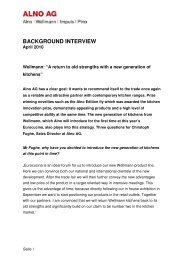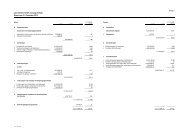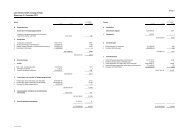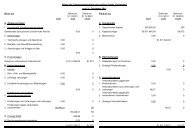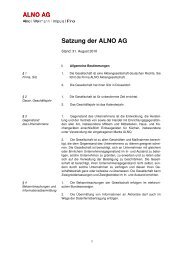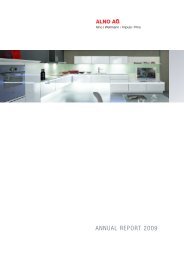The good prospects are based on the all-embracing ... - ALNO AG
The good prospects are based on the all-embracing ... - ALNO AG
The good prospects are based on the all-embracing ... - ALNO AG
Create successful ePaper yourself
Turn your PDF publications into a flip-book with our unique Google optimized e-Paper software.
2. CurreNCY rIsKs<br />
<str<strong>on</strong>g>The</str<strong>on</strong>g> currency risk refers to <strong>the</strong> risk of changes in <strong>the</strong> fair<br />
value or future cash flows of m<strong>on</strong>etary items <strong>on</strong> account<br />
of fluctuati<strong>on</strong>s in exchange rates.<br />
Currency risks basic<strong>all</strong>y arise from investments, financing<br />
activities and operating activities which <str<strong>on</strong>g>are</str<strong>on</strong>g> undertaken in<br />
a currency o<strong>the</strong>r than <strong>the</strong> company's functi<strong>on</strong>al currency.<br />
However, currency risks without impact <strong>on</strong> <strong>the</strong> Group's<br />
cash flows, e.g. due to translating foreign corporate entities'<br />
assets and liabilities into <strong>the</strong> Group currency, <str<strong>on</strong>g>are</str<strong>on</strong>g><br />
never c<strong>on</strong>sidered in fur<strong>the</strong>r detail by Group Treasury.<br />
<str<strong>on</strong>g>The</str<strong>on</strong>g>re was no material risk in <strong>the</strong> investment sector as at<br />
<strong>the</strong> balance sheet date.<br />
Currency risks in <strong>the</strong> financing sector arise from bank loans<br />
and loans <strong>on</strong> current account in foreign currencies, as<br />
well as from foreign currency loans which <str<strong>on</strong>g>are</str<strong>on</strong>g> extended to<br />
Group companies for financing purposes.<br />
As from 1 January 2010, <strong>the</strong> German plants basic<strong>all</strong>y<br />
invoice customers directly in Switzerland and <strong>the</strong> United<br />
Kingdom. Invoices <str<strong>on</strong>g>are</str<strong>on</strong>g> made out in euros. <str<strong>on</strong>g>The</str<strong>on</strong>g>re <str<strong>on</strong>g>are</str<strong>on</strong>g> c<strong>on</strong>sequently<br />
no major currency risks for <strong>the</strong> <strong>ALNO</strong> Group in<br />
<strong>the</strong> sales sector.<br />
<str<strong>on</strong>g>The</str<strong>on</strong>g> following table shows <strong>the</strong> effect of changes in <strong>the</strong> fair<br />
value of m<strong>on</strong>etary foreign currency items <strong>on</strong> Group profit/<br />
loss before income taxes. <str<strong>on</strong>g>The</str<strong>on</strong>g>re <str<strong>on</strong>g>are</str<strong>on</strong>g> no effects <strong>on</strong> equity<br />
outside profit and loss.<br />
Development of exchange<br />
rate<br />
Effect <strong>on</strong> result in '000 EUR<br />
Income (+)/Expense (-)<br />
GBP CHF GBP CHF<br />
2011 10.0 % 10.0 % 482 81<br />
– 10.0 % – 10.0 % – 482 – 81<br />
2010 10.0 % 10.0 % 248 102<br />
– 10.0 % – 10.0 % – 248 – 102<br />
C<strong>on</strong>soLidatEd FinanCiaL statEmEnts | manaGEmEnt oF FinanCiaL Risks<br />
3. INTeresT raTe rIsKs<br />
<str<strong>on</strong>g>The</str<strong>on</strong>g> interest rate risk refers to <strong>the</strong> risk of changes in <strong>the</strong> fair<br />
value or future cash flows of financial assets and liabilities<br />
<strong>on</strong> account of changes in current interest rates.<br />
<str<strong>on</strong>g>The</str<strong>on</strong>g> Group is primarily exposed to interest rate risks in<br />
<strong>the</strong> euroz<strong>on</strong>e. To minimize <strong>the</strong> effect of fluctuati<strong>on</strong>s in<br />
interest rates in <strong>the</strong>se regi<strong>on</strong>s, <strong>the</strong> interest rate risk for net<br />
financial liabilities made out in euros is managed by <strong>ALNO</strong><br />
<strong>AG</strong>. Financial liabilities in foreign currencies <strong>on</strong>ly exist to a<br />
subordinate extent. <str<strong>on</strong>g>The</str<strong>on</strong>g>re <str<strong>on</strong>g>are</str<strong>on</strong>g> no financial derivatives as at<br />
<strong>the</strong> balance sheet date.<br />
Financial liabilities and <strong>the</strong> variable-interest factoring volume<br />
have been taken into account in <strong>the</strong> following analysis<br />
of sensitivity to interest rate movements. Only financial<br />
liabilities with variable interest rates have been included in<br />
<strong>the</strong> analysis. <str<strong>on</strong>g>The</str<strong>on</strong>g> analysis is also <str<strong>on</strong>g>based</str<strong>on</strong>g> <strong>on</strong> <strong>the</strong> assumpti<strong>on</strong><br />
that <strong>the</strong> principal amounts and <strong>the</strong> ratio of fixed to variable<br />
interest rates remain unchanged.<br />
If <strong>the</strong> average interest rate were to be increased by 150<br />
(previous year: 150) basis points, <strong>the</strong> result before taxes <strong>on</strong><br />
income would decrease by EUR 1,352 thousand (previous<br />
year: EUR 1,451 thousand). A reducti<strong>on</strong> of 150 (previous<br />
year: 150) basis points would lead to an increase of EUR<br />
1,352 thousand (previous year: EUR 1,451 thousand) in<br />
profit/loss before income taxes.<br />
4. rIsK of defaulT<br />
<str<strong>on</strong>g>The</str<strong>on</strong>g> risk of default refers to <strong>the</strong> risk that a c<strong>on</strong>tractual partner<br />
fails to discharge its payment obligati<strong>on</strong>s in c<strong>on</strong>juncti<strong>on</strong><br />
with financial assets.<br />
Accounts receivable in operating business <str<strong>on</strong>g>are</str<strong>on</strong>g> c<strong>on</strong>tinuously<br />
m<strong>on</strong>itored at segment level, i.e. decentralized. In<br />
c<strong>on</strong>juncti<strong>on</strong> with Group receivables management, minimum<br />
requirements as regards creditworthiness and maximum<br />
exposure limits <str<strong>on</strong>g>are</str<strong>on</strong>g> defined for <strong>all</strong> business partners of <strong>the</strong><br />
<strong>ALNO</strong> Group. <str<strong>on</strong>g>The</str<strong>on</strong>g>se <str<strong>on</strong>g>are</str<strong>on</strong>g> <str<strong>on</strong>g>based</str<strong>on</strong>g> <strong>on</strong> a system of specified<br />
limits for which compliance is c<strong>on</strong>stantly m<strong>on</strong>itored. In<br />
additi<strong>on</strong>, <strong>the</strong> <strong>ALNO</strong> Group safeguards its trade receivables<br />
through domestic credit insurance which, if an account<br />
receivable is not paid, will indemnify <strong>the</strong> loss incurred in<br />
<strong>the</strong> c<strong>on</strong>tractu<strong>all</strong>y agreed amount. Specific valuati<strong>on</strong> <strong>all</strong>owances<br />
<str<strong>on</strong>g>are</str<strong>on</strong>g> used to take account of <strong>the</strong> risk of default. Trade<br />
receivables <str<strong>on</strong>g>are</str<strong>on</strong>g> secured through domestic credit insurance<br />
107





